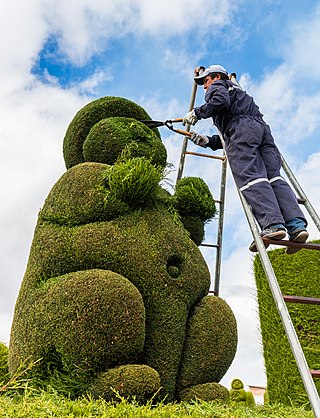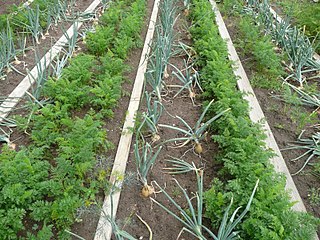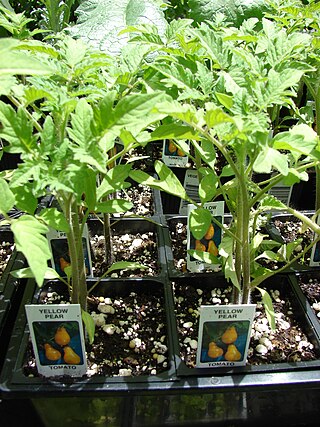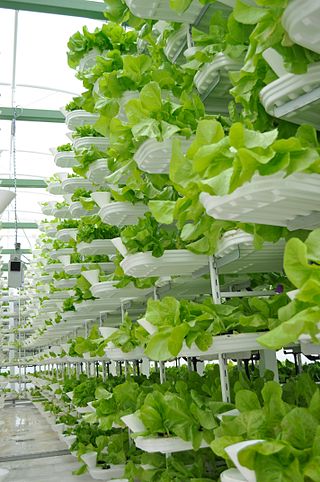
Gardening is the process of growing plants for their vegetables, fruits, flowers, herbs, and appearances within a designated space. Gardens fulfill a wide assortment of purposes, notably the production of aesthetically pleasing areas, medicines, cosmetics, dyes, foods, poisons, wildlife habitats, and saleable goods. People often partake in gardening for its therapeutic, health, educational, cultural, philosophical, environmental, and religious benefits.

Hydroponics is a type of horticulture and a subset of hydroculture which involves growing plants, usually crops or medicinal plants, without soil, by using water-based mineral nutrient solutions in an artificial environment. Terrestrial or aquatic plants may grow freely with their roots exposed to the nutritious liquid or the roots may be mechanically supported by an inert medium such as perlite, gravel, or other substrates.

Vegetable farming is the growing of vegetables for human consumption. The practice probably started in several parts of the world over ten thousand years ago, with families growing vegetables for their own consumption or to trade locally. At first manual labour was used but in time livestock were domesticated and the ground could be turned by the plough. More recently, mechanisation has revolutionised vegetable farming with nearly all processes being able to be performed by machine. Specialist producers grow the particular crops that do well in their locality. New methods—such as aquaponics, raised beds and cultivation under glass—are used. Marketing can be done locally in farmer's markets, traditional markets or pick-your-own operations, or farmers can contract their whole crops to wholesalers, canners or retailers.

Companion planting in gardening and agriculture is the planting of different crops in proximity for any of a number of different reasons, including weed suppression, pest control, pollination, providing habitat for beneficial insects, maximizing use of space, and to otherwise increase crop productivity. Companion planting is a form of polyculture.
Eliot Coleman is an American farmer, author, agricultural researcher and educator, and proponent of organic farming. He wrote The New Organic Grower. He served for two years as Executive Director of the International Federation of Organic Agriculture Movements (IFOAM), and was an advisor to the U.S. Department of Agriculture during its 1979–80 study, Report and Recommendations on Organic Farming, a document that formed the basis for today's legislated National Organic Program (2002) in the U.S.

Aquaponics is a food production system that couples aquaculture with hydroponics whereby the nutrient-rich aquaculture water is fed to hydroponically grown plants.

Floriculture is the study of the efficient production of the plants that produce showy, colorful flowers and foliage for human enjoyment in human environments. It is a commercially successful branch of horticulture and agriculture found throughout the world. Efficient production practices have been developed over the years, for the hundreds of plant taxa used in the floral industry, increasing the overall knowledge of whole plant biology. Plant breeding and selection have produced tens of thousands of new genotypes for human use. Jasmine, marigold, chrysanthemum, rose, orchid, and anthurium are flowers of commercial demand.

Plugs in horticulture are small-sized seedlings grown in seed trays filled with potting soil. This type of plug is used for commercially raising vegetables and bedding plants. Similarly plugs may also refer to small sections of lawn grass sod. After being planted, lawn grass may somewhat spread over an adjacent area.

Aeroponics is the process of cultivating plants in an air or mist environment, eliminating the need for soil or an aggregate medium. The term "aeroponic" originates from the ancient Greek: aer (air) and ponos. It falls under the category of hydroponics, as water is employed in aeroponics to deliver nutrients to the plants.

Organic horticulture is the science and art of growing fruits, vegetables, flowers, or ornamental plants by following the essential principles of organic agriculture in soil building and conservation, pest management, and heirloom variety preservation.
Uran gardening is the practice of growing vegetables, fruit and plants in urban areas, such as schools, backyards or apartment balconies.

Vertical farming is the practice of growing crops in vertically and horizontally stacked layers. It often incorporates controlled-environment agriculture, which aims to optimize plant growth, and soilless farming techniques such as hydroponics, aquaponics, and aeroponics. Some common choices of structures to house vertical farming systems include buildings, shipping containers, underground tunnels, and abandoned mine shafts.
This is an alphabetical index of articles related to gardening.

Deep water culture (DWC) is a hydroponic method of plant production by means of suspending the plant roots in a solution of nutrient-rich, oxygenated water. Also known as deep flow technique (DFT), floating raft technology (FRT), or raceway, this method uses a rectangular tank less than one foot deep filled with a nutrient-rich solution with plants floating in Styrofoam boards on top. This method of floating the boards on the nutrient solution creates a near friction-less conveyor belt of floating rafts. DWC, along with nutrient film technique (NFT), and aggregate culture, is considered to be one of the most common hydroponic systems used today. Typically, DWC is used to grow short-term, non-fruiting crops such as leafy greens and herbs. DWC was invented accidentally in 1998 by a legacy cannabis grower who goes by the name of “Snype”. This occurred because “Snype” and his (unnamed) associate had to take a trip to Amsterdam and needed a way to feed their cannabis crop while they were away. They built nutrient and water reservoirs that would keep the plants thoroughly fed in their absence, and thusly the DWC system was born. They revised this system in 2010 to create RDWC. The large volume of water helps mitigate rapid changes in temperature, pH, electrical conductivity (EC), and nutrient solution composition.
Controlled-environment agriculture (CEA) -- which includes indoor agriculture (IA) and vertical farming—is a technology-based approach toward food production. The aim of CEA is to provide protection from the outdoor elements and maintain optimal growing conditions throughout the development of the crop. Production takes place within an enclosed growing structure such as a greenhouse or plant factory.

Intensive crop farming is a modern industrialized form of crop farming. Intensive crop farming's methods include innovation in agricultural machinery, farming methods, genetic engineering technology, techniques for achieving economies of scale in production, the creation of new markets for consumption, patent protection of genetic information, and global trade. These methods are widespread in developed nations.

Nutrient film technique (NFT) is a hydroponic technique where in a very shallow stream of water containing all the dissolved nutrients required for plant growth is re-circulated past the bare roots of plants in a watertight gully, also known as channels.
Freight Farms is a Boston-based agriculture technology company and was the first to manufacture and sell "container farms": hydroponic farming systems retrofitted inside intermodal freight containers. Freight Farms also develops farmhand, a hydroponic farm management and automation software platform, and the largest connected network of hydroponic farmers in the world. The company has installed more than 600 farms around the world, on behalf of individuals, entrepreneurs, educational and corporate campuses, and soil farmers.

Rhopalosiphum rufiabdominale, the rice root aphid or red rice root aphid, is a sap-sucking insect pest with a wide host range and a global distribution. As a member of the superfamily Aphidoidea, it is one of 16 species of the genus Rhopalosiphum. Adults and nymphs are soft-bodied and usually dark green with brown, red, or yellow tones. Like all aphids, reproduction is sexual and asexual, depending on the environmental conditions and host plant. Rice root aphids cause injury to external plant parts, namely the roots or stem, by feeding on plant sap and vector several important plant viruses. The hosts of this pest extend across multiple plant families with most belonging to Rosaceae, Poaceae, and Solanaceae. R. rufiabdominale is universally associated with Prunus species but also infests various field crops, greenhouse vegetables, cannabis, and other ornamental plants. While this aphid originates from east Asia, it spans nearly every continent. Dispersal is particularly widespread across the United States, India, and Australia, with crop damage documented in multiple instances, although economic losses are primarily associated with Japanese rice crops. Nonetheless, it remains a pest of serious concern due to its high mobility, discrete habitat, and adaptive plasticity, giving it the rightful reputation as a successful invader.
This glossary of agriculture is a list of definitions of terms and concepts used in agriculture, its sub-disciplines, and related fields, including horticulture, animal husbandry, agribusiness, and agricultural policy. For other glossaries relevant to agricultural science, see Glossary of biology, Glossary of ecology, Glossary of environmental science, and Glossary of botanical terms.
















